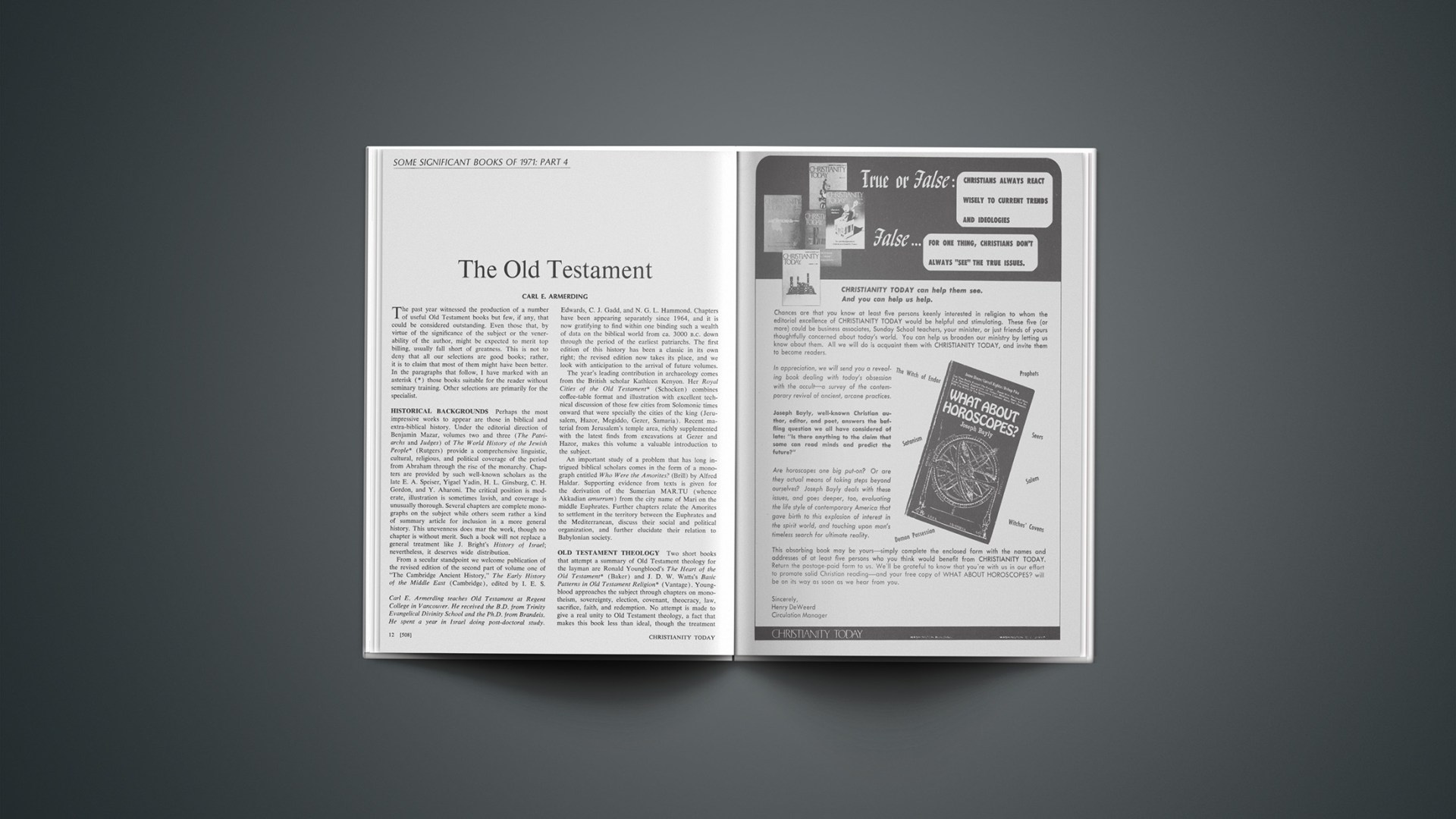The past year witnessed the production of a number of useful Old Testament books but few, if any, that could be considered outstanding. Even those that, by virtue of the significance of the subject or the venerability of the author, might be expected to merit top billing, usually fall short of greatness. This is not to deny that all our selections are good books; rather, it is to claim that most of them might have been better. In the paragraphs that follow, I have marked with an asterisk (*) those books suitable for the reader without seminary training. Other selections are primarily for the specialist.
HISTORICAL BACKGROUNDS Perhaps the most impressive works to appear are those in biblical and extra-biblical history. Under the editorial direction of Benjamin Mazar, volumes two and three (The Patriarchs and Judges) of The World History of the Jewish People* (Rutgers) provide a comprehensive linguistic, cultural, religious, and political coverage of the period from Abraham through the rise of the monarchy. Chapters are provided by such well-known scholars as the late E. A. Speiser, Yigael Yadin, H. L. Ginsburg, C. H. Gordon, and Y. Aharoni. The critical position is moderate, illustration is sometimes lavish, and coverage is unusually thorough. Several chapters are complete monographs on the subject while others seem rather a kind of summary article for inclusion in a more general history. This unevenness does mar the work, though no chapter is without merit. Such a book will not replace a general treatment like J. Bright’s History of Israel; nevertheless, it deserves wide distribution.
From a secular standpoint we welcome publication of the revised edition of the second part of volume one of “The Cambridge Ancient History,” The Early History of the Middle East (Cambridge), edited by I. E. S. Edwards, C. J. Gadd, and N. G. L. Hammond. Chapters have been appearing separately since 1964, and it is now gratifying to find within one binding such a wealth of data on the biblical world from ca. 3000 B. C. down through the period of the earliest patriarchs. The first edition of this history has been a classic in its own right; the revised edition now takes its place, and we look with anticipation to the arrival of future volumes.
The year’s leading contribution in archaeology comes from the British scholar Kathleen Kenyon. Her Royal Cities of the Old Testament* (Schocken) combines coffee-table format and illustration with excellent technical discussion of those few cities from Solomonic times onward that were specially the cities of the king (Jerusalem, Hazor, Megiddo, Gezer, Samaria). Recent material from Jerusalem’s temple area, richly supplemented with the latest finds from excavations at Gezer and Hazor, makes this volume a valuable introduction to the subject.
An important study of a problem that has long intrigued biblical scholars comes in the form of a monograph entitled Who Were the Amorites? (Brill) by Alfred Haldar. Supporting evidence from texts is given for the derivation of the Sumerian MAR.TU (whence Akkadian amurrum) from the city name of Mari on the middle Euphrates. Further chapters relate the Amorites to settlement in the territory between the Euphrates and the Mediterranean, discuss their social and political organization, and further elucidate their relation to Babylonian society.
OLD TESTAMENT THEOLOGY Two short books that attempt a summary of Old Testament theology for the layman are Ronald Youngblood’s The Heart of the Old Testament* (Baker) and J. D. W. Watts’s Basic Patterns in Old Testament Religion* (Vantage). Youngblood approaches the subject through chapters on monotheism, sovereignty, election, covenant, theocracy, law, sacrifice, faith, and redemption. No attempt is made to give a real unity to Old Testament theology, a fact that makes this book less than ideal, though the treatment throughout is accurate, biblical, and well cast in laymen’s language. Watts divides his Old Testament theology into three basic patterns: the patriarchal pattern, that followed by Abraham; the amphictyonic, the religion of Moses; and the monarchical, the religion of Israel after the Davidic period. Although the book is a valuable attempt to cast current Old Testament theology in a form useful for the layman, we could wish it were more the author’s own synthesis and a little less a popularization of the latest German scholarship.
Evangelicals will note with interest the appearance of the first of two volumes of a new work in biblical theology by a member of the Mennonite tradition. Chester K. Lehman’s Biblical Theology, Volume 1: Old Testament* (Herald) may not be the final answer to the need for a first-rate evangelical theology of the Old Testament, but it will be a valuable addition to the limited literature in the field. Lehman cheerfully acknowledges his dependence on the work of Gerhardus Vos, and in a sense his book is an attempt to set forth the principles of historically based revelation in the tradition of the great Princeton scholar.
Of standard works in the same field, no one-volume presentation has had wider reception than An Outline of Old Testament Theology (Blackwell) by Th. C. Vriezen. Students will welcome a fully revised and enlarged edition that appeared in 1971, taking into account current work (particularly that of von Rad) and arguing strongly for the unity of Old Testament theology.
EXEGETICAL TOOLA Concise Hebrew and Aramaic Lexicon of the Old Testament (Eerdmans), edited by William Holladay, meets a longstanding need for a lexicon intermediate between pocket-size glossaries and massive, expensive tomes. This is a skillful abridgment, using the latest available portions, of the Koehler-Baumgartner lexicon, which remains valuable for the specialist. Seminarians and pastors will be well served by this tool.
BIBLICAL CRITICISM AND INTRODUCTION The year’s leading contribution comes in the form of a published dissertation from Rome. Sean A. McEvenue, in The Narrative Style of the Priestly Writer (Pontifical Biblical Institute), has produced a most engaging literary study comparing passages of the so-called P Document with various genres of children’s literature. As a book that challenges deeply held assumptions (e.g., that “P” is a “rather superficial, pure, bloodless, theological writing”), this work is sure to provoke some reaction and open an old subject to new forms of debate.
A second significant work, Joel and the Temple Cult of Jerusalem (Brill) by G. W. Ahlstrom, considers the terminology, phraseology, and historical allusions in the Book of Joel. The author concludes from his detailed and comprehensive study that the prophecy was an attack on syncretistic and idolatrous elements within the cult of the second temple, sometime between 515 and 500 B. C. A closing chapter on composition finds the oracles of Joel originally spoken to the people of Jerusalem and later written down, either by the prophet or by some of his disciples, with no verses that need be considered secondary.
MONOGRAPHS ON BIBLICAL-THEOLOGICAL THEMESMan, God’s Eternal Creation* (Moody) by R. Laird Harris is a potpourri of data about man found in the Old Testament. The author, long known for ingenious, if not always convincing, solutions to problems of Old Testament history, has now brought together in one volume much of his collection (e.g., the Hebrew word for “flood” means “storm,” and what covered the higher regions was a snowstorm lasting most of a year!). A significant part of the book is devoted to questions of science and Scripture, with chapters on culture, worship, warfare, and the afterlife to round out the feast.
A second stimulating monograph studies the relation between the eighth-century Isaiah and the wisdom movement of that day. J. William Whedbee’s Isaiah and Wisdom (Abingdon), originally a Yale dissertation, looks at the parables, proverbs, and woe oracles in Isaiah, together with the attitude of the book toward counsel and counselors. Whedbee concludes that Isaiah manifests strong influences from the wisdom traditions of the Jerusalem court, part of which involved his use of wisdom forms to meet the problems of eighth-century Judah. This context, according to the author, provided a creative stimulus for Isaiah in shaping his message to the needs of his day.
Our next selection doubles as an introduction to the Wisdom books and a study of wisdom in its general biblical setting. The Way of Wisdom in the Old Testament* (Macmillan) by R. B. Y. Scott is designed for the general reader and presents wisdom as a movement in Israel with an influence equal to that of the prophets. Scott points out the considerable common ground between the wise men and the prophets, though acknowledging their differences, and stresses the need for wisdom’s message in the midst of our morally confused contemporary society.
Some old but much new ground is covered in Carroll Stuhlmueller’s Creative Redemption in Deutero-Isaiah (Pontifical Biblical Institute), a book that reaffirms the primacy of the redemption theme in Isaiah 40–55 and thoroughly explores the subordinate theme of creation in its relation to redemption. Here is a volume that demonstrates the continuing quality of doctoral work being done at the Pontifical Biblical Institute and provides a focal point for all future discussion of an important theological motif.
Yet another provocative book that originated as a doctoral dissertation, this one at Cambridge, is Ancient Israel’s Criminal Law (Schocken) by Anthony Phillips. Phillips argues that there was a clear distinction between criminal and civil offenses in Israel, and that the Decalogue with its covenant stipulations was in fact Israel’s criminal code. After examining each of the “Ten Words,” the book closes with a short history of the concept of criminal law in Israel from the time of Sinai through the post-exilic period.
COLLECTED ESSAYS It has recently become popular to collect in one volume some of the more important journal articles written by a scholar of note. Readers will welcome the appearance in English of fifteen essays from the pen of the late Dominican Roland deVaux, under the title The Bible and the Ancient Near East (Doubleday). Outstanding articles discuss biblical interpretation (e.g., “The Remnant of Israel”), archaeology (“The Sacrifice of Pigs in Palestine”), and biblical theology (“Is it Possible to Write a ‘Theology of the Old Testament’?”).
A second collection of essays, also from a Roman Catholic scholar, is “in large measure a by-product of editorial work on the New American Bible.” Studies in Israelite Poetry and Wisdom (Catholic Biblical Quarterly Monographs) offers twenty-six articles by Monsignor Patrick W. Skehan, most of which have to do with translation problems in the Wisdom books. Ten of the author’s book reviews and a complete bibliography of his work complete the volume.
A significant collection of technical essays appeared in honor of the best-known biblical archaeologist on his eightieth (which proved to be his last) birthday. Near Eastern Studies in Honor of William Foxwell Albright (Johns Hopkins), edited by Hans Goedicke, includes thirty-four contributions, most of them bringing archaeological discovery to bear on specific Old Testament questions.
Two further anthologies are concerned with Ancient Near Eastern backgrounds to the Bible. Toward an Image of Tammuz and Other Essays (Harvard) brings together the best work of the great Sumerologist Thorkild Jacobsen. Several articles on history and mythology will commend themselves to biblical students (note especially the title article) while grammarians will appreciate authoritative treatment of Sumerian and Akkadian verbs. A second, smaller book, Essays on the Ancient Semitic World (University of Toronto), edited by J. W. Wevers and D. B. Redford, combines three articles on Assyria and Egypt with four useful studies in Hebrew philology. The latter category includes a fresh approach to metrical analysis in Hebrew poetry, an article on the passive Qal, and two articles on Hebrew phonics.
COMMENTARIES The past year saw the appearance of several exegetical commentaries, though none of the scope that has marked publications of recent years. Two volumes were issued in “The New Century Bible” (Oliphants). J. Philip Hyatt’s Exodus* is committed to classical documentary division of the book, but contains helpful introductory material and a clear exposition of the text. Useful for the same reasons (though, like all volumes in the series, overpriced) is First and Second Samuel* by John Mauchline. Particularly valuable in both volumes is the wealth of contemporary bibliographical data.
Contributions to Doubleday’s “Anchor Bible” are still coming out slowly. Nineteen seventy-one brought only Carey A. Moore’s slim but scholarly treatment of Esther*. Although not all readers will be comfortable with his skepticism regarding historical material, all will welcome his thorough treatment of the text and extensive introductory section.
Among the prophets three books deserve mention. The verse-by-verse expositions of H. C. Leupold are by now familiar to most readers. His Exposition of Isaiah, Volume II* (Baker) covers chapters 40–66 and follows the same format as the previous volume. Though rejecting a second and third Isaiah, Leupold freely admits that the material of the prophecy “obviously implies that the Exile … has taken place.…” From there on, matters of introduction are generally passed over in favor of a running commentary on the text.
From the Dispensational perspective comes another book on the Prophet Daniel. Daniel, the Key to Prophetic Revelation* (Moody) by John F. Walvoord is primarily a theological and historical commentary. The author is well versed in all prophetic positions and quotes various authorities widely, but gives too little help to the student seeking to understand the meaning of the text itself.
A third book is just the opposite of Walvoord’s. The Book of Amos (Schocken) by E. Hammershaimb is short on theology but presents in English translation a splendid and detailed commentary on the Hebrew text of the prophet. This is not a book for the beginner, but the serious student of Amos will find each page rich in philological detail.
Misplaced Humility
Humility was largely meant as a restraint upon the arrogance and infinity of the appetite of man. He was always outstripping his mercies with his own newly invented needs.…
But what we suffer from today is humility in the wrong place. Modesty has moved from the organ of ambition and settled upon the organ of conviction; where it was never meant to be. A man was meant to be doubtful about himself, but undoubting about the truth; this has been exactly reversed. Nowadays the part of a man that a man does assert is exactly the part he ought not to assert—himself. The part he doubts is exactly the part he ought not to doubt—the Divine Reason.—G. K. CHESTERTON in Orthodoxy (copyright 1936 by Dodd, Mead).
SHORTER COMMENTARIES AND SERMONIC COLLECTIONS The books that follow make no claim to be full, exegetical works, but have a value commensurate with a more limited purpose in writing. Deuteronomy: The Gospel of Love* (Moody) by Samuel J. Schultz is a worthy addition to the brief volumes of the “Everyman’s Bible Commentary.” Also issued in 1971 were the first two Old Testament volumes in “The Cambridge Bible Commentary on the New English Bible.” The First Book of Samuel* by Peter R. Ackroyd and Amos, Hosea, Micah* by Henry McKeating are useful if used with discretion and supplemented by something more in depth. The latest in Zondervan’s “Study Guide” series is the slender but carefully written Job* by D. David Garland. On the Psalms, two books of sermons are offered for the first time. Those familiar with the radio preaching of David A. Hubbard (“The Joyful Sound”) will welcome Psalms For All Seasons* (Eerdmans), a paperback book of meditations on thirteen key psalms. Less familiar to most Americans is the Dutch preacher-theologian G. Th. Rothuizen, whose thoughts about the witness of each of the first fifty psalms are presented in Landscape* (John Knox). The chapters are both devotional and practical, and Rothuizen’s work should find a wide audience in conservative circles, despite the distinctly Dutch flavor of the work.
Our next book is neither a commentary nor a collection of sermons. Jacques Ellul, one of today’s most stimulating thinkers, presents in The Judgment of Jonah* (Eerdmans) a Jonah who is theologically related to the Christian. The worth of Ellul is not in the small details of theology but in the sometimes disturbing but never merely comforting direction of his thought.
A further monograph on a prophet challenges traditional views on the background of much of Jeremiah. Preaching to the Exiles (Schocken) by E. W. Nicholson concludes that much of the prose tradition of that prophet is theological writing originating with the “Deuteronomists” on the basis of some “original sayings of Jeremiah.”
Finally, mention should be made of two short books that are more history than commentary but follow a biblical outline. Solomon to the Exile* (Baker) by John C. Whitcomb is little more than a running historical commentary on the events described in the Bible for that period. But the author has a good knowledge of secular sources, and the book will be useful to those who want help in this area. Quite an opposite critical approach is taken by Peter R. Ackroyd in a volume in “The New Clarendon Bible,” Israel Under Babylon and Persia* (Oxford). Whereas Whitcomb might be accused of ignoring obvious problems in biblical history, Ackroyd assumes a critical reconstruction that enables him confidently to include in the literature of his period such works as the Deuteronomic History and the Priestly Work. Nevertheless, the book presents a wealth of historical and exegetical material and is a worthy addition to the series it represents.
ADDITIONAL VOLUMES OF NOTE In the field of introduction, James K. West’s Introduction to the Old Testament* (Macmillan) is designed for the college market. It is well written and illustrated, but not meant to replace the standard reference works. Two short handbooks that meet a real need are Literary Criticism of the Old Testament* by N. C. Habel and Form Criticism of the Old Testament* by G. M. Tucker (both Fortress). Both authors are committed to the subjects they discuss and give a brief (if sometimes too facile) case for the use of the method in question. In the field of Semitic linguistics, John C. L. Gibson’s Textbook of Syrian Semitic Inscriptions, Volume 1: Hebrew and Moabite Inscriptions (Clarendon) replaces G. A. Cooke’s standard though outdated work. Although this is now the best text available in English, most students of the subject will continue to use the German work of H. Donner and W. Rollig. Also in the field of linguistics is the massive work of Saul Levin, The Indo-European and Semitic Languages (State University of New York). If the author’s claims are correct, Hebrew shares with Sanskrit and Greek certain common concepts and development, and the widely held view of separate development of the families will have to be abandoned. A very different kind of volume, designed for Roman Catholic laymen but of use to a Protestant audience as well, is Evode Beaucamp’s Prophetic Intervention in the History of Man* (Alba House). Father Beaucamp has written a clear and readable introduction to each of the major prophets. Finally, a plum for the student of rabbinics comes in Judah Goldin’s scholarly book The Song at the Sea (Yale), a commentary on the oldest extant Jewish commentary (The Shirta) on Exodus 15.
SIGNIFICANT REPRINT OR PAPERBACK EDITIONS The top news in this section is Kregel’s reprint of the classic work of E. W. Hengstenberg, Christology of the Old Testament*. This work, first issued in a 700-page abridgment in English in 1847, is possibly the most complete commentary on Messianic predictions ever written. Though it is photomechanically reproduced, the type is clear and the format pleasant. The publisher is to be congratulated for having made this classic again available and at such a reasonable price.
From Zondervan have come useful paperback editions of two small books by H. L. Ellison. Job: From Tragedy to Triumph* (1958) and The Old Testament Prophets: Men Spake From God* (1952) are handbooks known to many but should have an even wider audience in their new dress.
Finally, a more technical and recent study that is now available in paperback is Klaus Koch’s The Growth of the Biblical Tradition (Scribners), a book that three years ago provided the English-speaking world with its first complete study of form criticism.
SUMMARY Although 1971 may not have been “the year of the book” for followers of the Old Testament scene, the contributions show the continuing vitality of certain fields, particularly Old Testament history and theology. The current year promises a better selection of commentaries, and we may hope that the supply of stimulating theological work will continue unabated. Happy reading!
Carl E. Armerding teaches Old Testament at Regent College in Vancouver. He received the B.D. from Trinity Evangelical Divinity School and the Ph.D. from Brandeis. He spent a year in Israel doing post-doctoral study.










